
Rural Coalition
The Rural Coalition is a non-profit organization in Washington, DC, assisting impoverished rural people and farmers in the United States and Mexico, especially in the United States.
I went to Mexico with the Rural Coalition. This gave me an opportunity to see first hand the struggle of indigenous people defending their land from the encroachment of the agribusiness-government complex. The Rural Coalition is symbolic of one of the greatest tragedies of the twentieth century: the undoing of rural societies and their replacement by agribusiness machines.
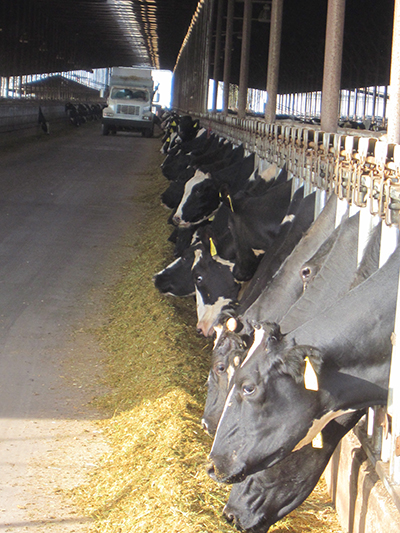 Animal farm, California. (Photo: Evaggelos Vallianatos)The Rural Coalition thinks in terms of food self-sufficiency or, as the current fashion dictates, “food sovereignty.” Food sovereignty is a new political flag of worldwide agrarian resistance to giant agriculture.
Animal farm, California. (Photo: Evaggelos Vallianatos)The Rural Coalition thinks in terms of food self-sufficiency or, as the current fashion dictates, “food sovereignty.” Food sovereignty is a new political flag of worldwide agrarian resistance to giant agriculture.
America does not have many small farmers and no peasants. America has a small number of very large farms owning most of the best land and producing most of the country’s food.
The effects of this giant agriculture are also gigantic: massive pollution, substantial global warming impact, forced exodus of rural people to the cities, poisoning of drinking water and food, bad public health and diminishing democracy.
America’s giant agriculture spills over into Mexico, disrupting the Mexican peasants’ sacred corn. In such a context, the Rural Coalition becomes the moral voice of rural people and, occasionally, speaks truth to power. The Rural Coalition empowers small family farmers, peasants and indigenous people who reject giant agriculture.
Giant Agriculture and Its Enemies
I have been studying the development and effects of giant agriculture in the United States and the world since 1975. Giant agriculture is made up of large farms and agribusiness operations like confined animal farms, slaughterhouses, and food and feed processing. Most of the time, the word “agribusiness” includes all of the above: large farms and industrialized food production. I use “large farms” and “agribusiness” interchangeably.
The opposite of giant agriculture is small farming made up of very small family farmers or peasants. The practitioners of small farming may use small-scale machines, but, in general, they don’t use pesticides or synthetic fertilizers or genetic engineering. If they resort to pesticides and fertilizers, they use them sporadically and in small amounts.
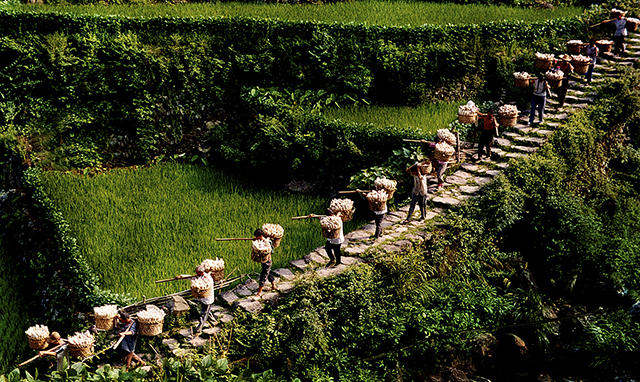 Chinese peasants at work. (Photo: Center for China Rural Civilization Studies, Beijing, China)
Chinese peasants at work. (Photo: Center for China Rural Civilization Studies, Beijing, China)
These agrarian people raise food for more than its nutrition. Food and land give them self-reliance and independence. Land is everything for them.
In the beginning of the first book of his “Politics,” Aristotle said self-reliance (autarkeia) is the purpose and perfection of the polis (1253a1). Thus food sovereignty, inconceivable in the absence of self-reliance, has a distinguished history. I hasten to add, however, the name food sovereignty is of recent vintage. Autarkeia means independence. Autarkeia spoke to the democratic politics of the Greeks; food sovereignty subverts the undemocratic politics of our times, especially the politics of large farms.
The problem with large farms is not merely one of size and intense mechanization. The problem is also political. Once they surround a town, they suck the life out of it, converting it into an agglomeration of people and machines.
We see similar consequences throughout the world. Mexico mirrors this global disaster because it is next to the United States. American farm missionaries reconstituted Mexican agriculture on the American model.
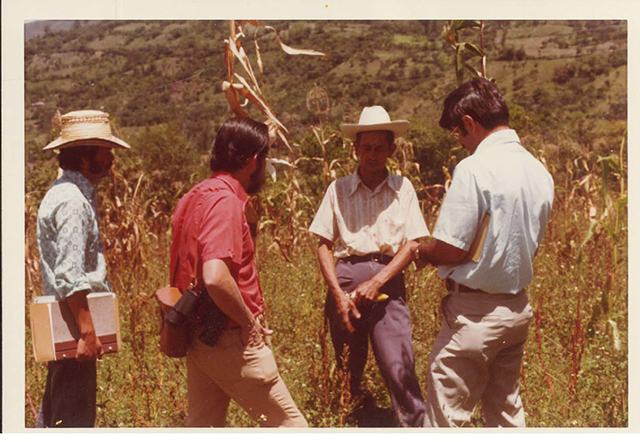 Evaggelos Vallianatos (right) researching peasant farming in Valle del Cauca, Colombia, summer 1975. (Photo: unknown photographer)
Evaggelos Vallianatos (right) researching peasant farming in Valle del Cauca, Colombia, summer 1975. (Photo: unknown photographer)
Rural organizations in the US have joined forces with campesino (peasant) movements in Mexico. This new agrarian movement, Rural Coalition, is focusing on food sovereignty as a political and agricultural antidote to the hegemony of giant agriculture.
The Rural Coalition appeals to me because its vision remains agrarian, advocating the 1937 prayer of the Southern Tenant Farmers’ Union: “Speed now the day when the plains and the hills and all the wealth thereof shall be the peoples’ own.”
What prayer and dream and political goal could be more timely and beautiful?
I attended two of the bi-national assemblies of the Rural Coalition in Mexico; the first in 1999 in the land of the Tarahumara in Chihuahua and the second in 2006 in Mexico City.
The Brave Tarahumara, 1999
 Farm Worker Center, El Passo, Texas. (Photo: Evaggelos Vallianatos)
Farm Worker Center, El Passo, Texas. (Photo: Evaggelos Vallianatos)
I observed and listened carefully to the discussion of the participants of the Rural Coalition in their assemblies in Mexico. I also went beyond the limits of the conferences and with the assistance of two Mexican experts, Gaspar Mayagoitia Panagos and Carlos Marentes, I decoded the suppressed culture of indigenous communities, indeed, all those looking up to the Rural Coalition. How can they go on opposing the goliath coming at them through church and state?
We left the farm worker center of Carlos Marentes in El Paso, Texas, in two buses for Juarez and Chihuahua, Mexico. Our destination was Creel, the tourist capital of the Sierra Madre Occidental, the world of the Tarahumara in southwest Chihuahua, 415 miles south of El Paso, Texas. Once in Creel, a magic process of time travel brought me back to my early childhood.
I was born in a mountain village like Creel. But in contrast to the one main street of Creel, Calle Adolpo Mateos, my village in a Greek Island, had narrow stone paths lined with almond, walnut, fig and olive trees. But both places are tacked on a protecting mountain; the myriad flowers, fruit trees, and the intimate relations of the peasants with nature, the absence of artificiality, rushed all kind of emotions in me as I was drinking in the sun in the cool morning of the Tarahumara who are only passers-by in their own land at Creel, a rail junction and a timber camp and a tourist trap only some twenty or so miles from Copper Canyon, as spectacularly awesome as America’s Grand Canyon.
I listened to the Tarahumara say they are losing most of their land in the small valleys and, now that they are forced to the mountains, they are powerless to resist the robbers of their water and forests. They resent the Mexican government’s policies weakening and destroying their traditions, particularly Mexico’s industrializing agriculture that is bringing America’s hybrid and bioengineered corn to undermine their sacred corn without which their culture becomes empty and meaningless.
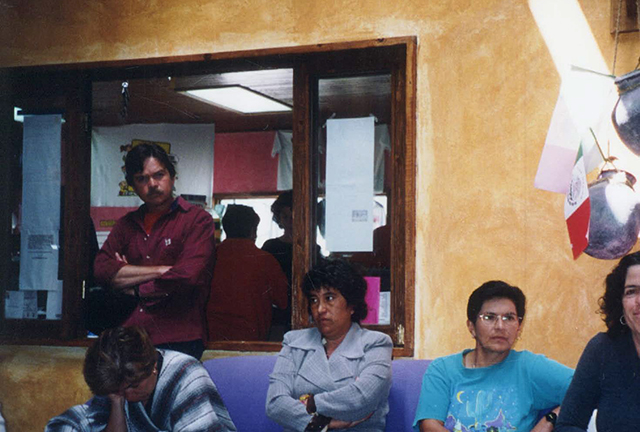 Rural Coalition conference, Creel, Sierra Madre Occidental. (Photo: Evaggelos Vallianatos)
Rural Coalition conference, Creel, Sierra Madre Occidental. (Photo: Evaggelos Vallianatos)
Colonizers – particularly the Jesuits and other Christian expert orders, including the Mennonites from the United States – in vain burned their disorienting and business monotheism onto the polytheistic soul of the recalcitrant people of the Sierra Madre. The Raramuris are still worshipping the sun, the moon, and other gods next to superficial Christian practices, which they follow routinely for purposes of survival.
The Marist monks I met at Creel, and with whom I had lunch at their handsome and hospitable monastery, said they “educate” young Tarahumara. But they educate the young Rarámuri to do what? Not exactly to retain their indigenous culture which is the exact opposite of the official Mexican Christian culture.
I asked the largely European monks to tell me whether and how they practice “liberation theology”- the half-hearted social programs of Catholic missionaries and theologians in Latin America in the 1960s to help the indigenous people escape or resist the colonizing culture of the dominant societies. They said I ought to ask the Pope and the US State Department that question. They, on their part, had been ordered to stay clear of Mexico’s social policies affecting the Tarahumara.
When the members of the Rural Coalition settled in the log cabins of the KOA – Kampground of America – at the only valley in the heart of Creel, they joined a few Rarámuri elders for a thanksgiving celebration. The North Americans formed a circle in the midst of which the Rarámuri set a symbolic wooden cross, some corn, food and liquids for their libations to the gods. A very old man, bronzed and lean, started to take slow steps back and forth before the offerings, which quickly evolved to a vigorous dance to the music of violins and a special cither designed by craftsmen of the Tarahumara community. Soon, other old Rarámuri men dressed in paper costumes and jingling shells, and women wearing their traditional hand-woven wide skirts and colorful shirts, blouses and silk handkerchiefs joined the dance. One of the men with slacks and very old shoes, from time to time, would utter a cry while he swayed his dark body.
While the Tarahumara ceremony was reaching its climax, a helicopter of the Mexican army, from a base about 300 meters away, barely visible behind the trees and vegetation, started flying over all of us in the circle around the dancing Rarámuri. The message was obvious and provocative. The ceremony ended rather quickly, but not before we took a sip from a drink the Rarámuri prepared to celebrate our friendship and give thanks to the gods.
I spent my second day at Creel with a Mexican colleague, Gaspar Mayagoitia Penagos. He is an American-educated biologist struggling to return to the principles of sustainable agriculture. He is also a political refugee from the violence and war at Chiapas. He and I visited Chogita, Bocoyna, San Juanito and Cusarare, four mountain Tarahumara communities, which, with some technical assistance from Gaspar Mayagoitia Penagos, are already doing something to become self-reliant in food.
I remembered the discussions I had with Colombian peasants in the summer of 1975 in the mountainous state of Santader and the prosperous Valle del Cauca. Gaspar was like the friendly Colombian agronomist who opened the door for me to the pain and suffering and resilience of the Colombian campesinos. Now, in the fall of 1999, in the mountains of Mexico, I found myself with people I could understand.
Meanwhile, my eyes were all over their land – its special contours, aroma, and colors touching my heart and healing my soul. The small wooden cabins, makeshift homes, with only the bare essentials, barns, at the edge of the forest right next to modest stretches of fertile land, surrounded by mountains, the fruitful gardens, the farm animals, the waving green sacred corn grown next to the yellow, nearly golden, wild, waist-high flowering plants, and the people themselves, Tarahumara, handsome, defiant, trying desperately to recreate their food security, teaching their children their own language and bringing them up to worship their ancestral gods, was like a rediscovered Arcadia. I was stunned. I fell in love with both the people and the exquisite nature of their mountains – so full of tragedy, so beautiful, so pillaged, so much colonized – and yet hopeful.
Their material culture is so Spartan, frugal and simple, that, in the United States, the Tarahumara would be classified very poor. Yet these peasants met us with a smile, pleased that we visited them. They looked us straight in the eyes and, with great satisfaction; they showed us their vegetable gardens and sacred corn. We then took our time to exchange ideas as if we knew each other for a very long time. Gaspar made himself at home, and I only asked a few questions to satisfy my curiosity and increase my pleasure in being their guest. The vegetables and corn were there, all around us, green, attractive, and reddish and tall, like the indigenous amaranth – the hot sun and mountain breeze bathing them with life. But we – a Tarahumara, a Mexican, and I – tried to also get close to that life.
Mexico City, 2006
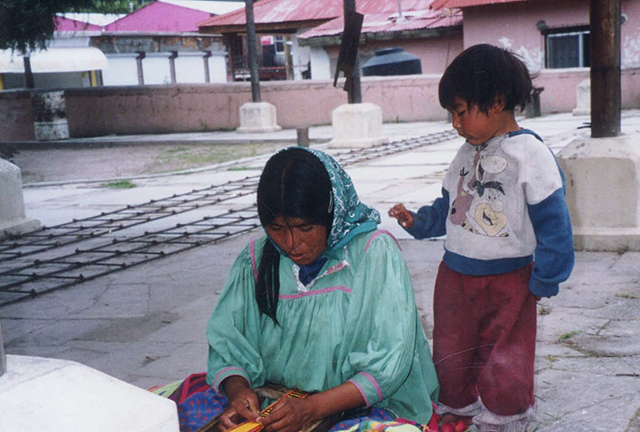 Tarachumara mother and child, Creel, Sierra Madre Occidental. (Photo: Evaggelos Vallianatos)
Tarachumara mother and child, Creel, Sierra Madre Occidental. (Photo: Evaggelos Vallianatos)
Seven years after my brief encounter with the indigenous people of Chihuahua, I found myself in Mexico City, the pre-Hispanic Navel of the Moon. Now Mexico City retains little of its pre-Hispanic nature; it is some kind of “navel of the moon,” but this navel is all but hidden by the clouds of conquest. Mexico City is the world’s largest “city” of about 30 million inhabitants, which means it is not a city in the Greek meaning of a city: a polis, a small, political community.
Mexico City is too massive in size to be that. It is rather a colossal conglomeration of thousands of acres of landconverted into endless rows of homes, churches, factories, shops, roads, highways and other lifeless structures covering an area of 1,700 square kilometers.
Mexico City, however, is the heart of Mexico, a vibrant and ancient culture that endured Herman Cortes’ extraordinary European conquest.
The Spanish conquistadors of the Aztecs were full of hatred for dark-skinned people who were neither European nor Christian. In addition, the Spanish conquistadors were coming from a Europe then fighting religious wars. Fanaticism was their ideology. They used genocide against the Aztecs, destroying Tenochtitlan and enslaving the surviving Aztecs. Then the Spanish masters of the Aztecs forced them to build a new country, a New Spain, right on the ruins of the world of their ancestors.
This vague and violent history was all over my mind in late September 2006 while walking the streets of Mexico City for the first time of my life. I was there with my Mexican friend Carlos Marentes.
Carlos Marentes and I were attending a conference of the Rural Coalition in Avenue Xochiquetzal 255, a dormitory–like training school: CENAMI, National Center for Indigenous Missions, dedicated to Santa Cruz. Here in this Spartan environment decorated with icons of crucified Jesus, indigenous people from Mexico’s countryside would learn practical crafts and respect for the Jesus religion.
Now, in late September 2006, some 80 members of grassroots organizations from the US and Mexico met under the umbrella of Rural Coalition to discuss their problems and reach agreement on a common strategy. Despite the powerlessness of the members of the Rural Coalition – or because of it -the debate was lively, bordering on an idealistic conclave trying to construct a new republic, a classless world without borders where justice and democracy would be the rule: a society where farming and food would be the highest priorities of rural communities, that is, food sovereignty would become agricultural policy. Which is to say, no one goes hungry and the small family farmers and campesinos have adequate land for growing their crops and having a good life.
La Via Campesina, a global grassroots peasant movement, has been lobbying the international system for several years on behalf of small farmers, campesinos, biodiversity, and indigenous people. It has made food sovereignty a respected policy option in societies struggling to get out of the colonial legacy of the plantation.
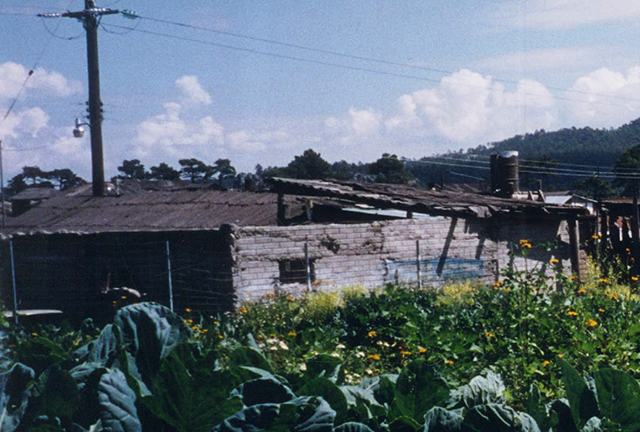 Tarachumara farm, Chihuahua, Mexico. (Photo: Evaggelos Vallianatos)
Tarachumara farm, Chihuahua, Mexico. (Photo: Evaggelos Vallianatos)
That colonial legacy was very nasty: most of the best land went to a few families, the rest being either landless or in possession of very little land or unproductive land. Those few countries that have made efforts to correct past injustices always apply agrarian reform to doing away with the gross deformities of landlordism.
Seen in this spirit, food sovereignty focuses attention on the dangerous imbalance between city and countryside, between the massive accumulation of land and power by agribusiness and plantations and the near landlessness and landlessness of peasants and the precarious status of small family farmers in North America and Europe. Food sovereignty, in fact, captures the expectations of peasant culture and of small family farmers, especially those pushed to the brink of extinction.
For example, the twentieth century proved catastrophic for small family farmers in the United States, especially those with black skin. About 60 to 80 percent of the white family farmers were forced out of agriculture; black farmers declined by 98 percent.
This threat of landlessness strikes fear in the heart of Mexican campesinos. Loss of land means disaster and, possibly, death. Corn and beans are indispensable in the life of the Mexican campesino, in the life of Mexico. While at CENAMI in Mexico City, we ate beans and some food combination of corn three times a day. Corn is Mexico and Mexico is corn. Thus bringing into Mexico, especially in the states of Oaxaca and Chiapas, two of Mexico’s most impoverished regions, “free trade” – that puts to auction the land of the peasant like it was a commodity – is an invitation to the dissolution of Mexican culture and Mexico.
Corn was the chief complaint of the campesinos at the Rural Coalition conference. They worried about the introduction of American corn, produced cheaply by state-subsidized giant agribusiness firms and large farmers in the USA into Mexico. North American corn competes with Mexico’s own campesino corn. The campesinos blamed the North American Free Trade Agreement for that. So they demanded that NAFTA be renegotiated, leaving agriculture out of its trade pact. They worried also that the imported American corn, mostly hybrid and genetically engineered, could contaminate their corn with catastrophic consequences.
In contrast to the Mexican campesinos’ focus on corn and food sovereignty, the American representatives of the Rural Coalition talked more the language of technical experts about the US farm bill, hoping beyond hope they could find some Congressman to insert a line or two into the farm bill about the rights of minority farmers (black and Hispanic) and farm workers.
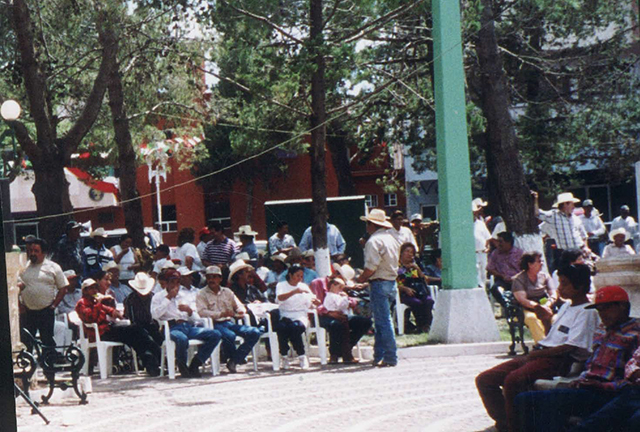 Indigenous rural people, Cuauhtemoc, Chihuahua, Mexico. (Photo: Evaggelos Vallianatos)
Indigenous rural people, Cuauhtemoc, Chihuahua, Mexico. (Photo: Evaggelos Vallianatos)
I kept reminding the conferees that there was one concrete step minority farmers could take in remaking their lives for the better. That was becoming organic farmers, abandoning the poisons of agribusiness for their own traditional practices, returning to their roots. Organic farming, I said, would mean a positive transformation for both the economic survival and well being of minority farmers and campesinos.
However, what touched me the most was the campesinos’ quiet determination to maintain their culture, defend their sacred corn, practice and live – to the degree they could – food sovereignty, teaching each other, bringing the encouraging message of the Rural Coalition to their communities that other people like them, those from North America, cared for them.
Our conference ended with a celebration: Oaxaca dancers dazzled us with their simple but beautiful dances, ancient display of music, unity, craftsmanship, and fun.
Each time the Federation of Southern Cooperatives saves black farmers from going under, that is a victory of the Rural Coalition. Each time Mexican organizations and campesinos resist, as they have been doing in Oaxaca and Chiapas, state violence and the temptation of selling the campesinos’ land, that is a victory of the millennial Mexican corn culture and Mexican democracy.
The very existence of the Carlos Marentes center in El Paso, Texas, is a permanent sign of resistance against forces of oppression. That center is a sanctuary for Mexicans risking everything for growing and harvesting America’s crops.
From Prayers to Actions
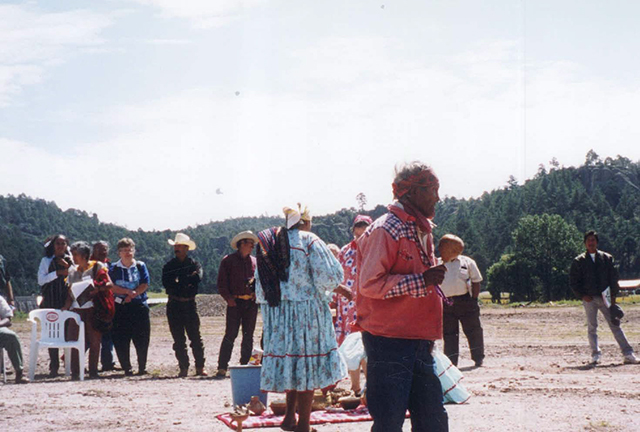 Raramuri religious ceremony, Creel, Sierra Madre Occidental, Mexico. (Photo: Evaggelos Vallianatos)
Raramuri religious ceremony, Creel, Sierra Madre Occidental, Mexico. (Photo: Evaggelos Vallianatos)
Looking back at Rural Coalition, I worry that the 1937 tenants’ prayer of the land is not enough to bridge the huge gap between a dream (food sovereignty) and the harsh reality of the agribusiness colossus eating most farm land and democracy.
Of course, Carlos Marentes continues with his humanitarian work at El Paso. And the Rural Coalition in Washington, DC, remains a symbol for the rural powerless in the Americas: lobbying and begging the powerful to be less harsh to farm workers, and begging even more from “philanthropic” foundations for meager funds to stay alive.
Academics in the country’s agricultural (land grant) universities pretend all is fine, industry money keeping them from inquiring too deeply into landlordism, agrarian reform and the deleterious consequences of farm sprays and environmental pollution.
As for the professors and scientists of the non-agricultural universities and colleges, they are, with some exceptions, in deep slumber. They teach humanities, computers, engineering, physics and mathematics and even environmental studies and science, but they willfully ignore agriculture and the capture of the countryside by large farmers. They also ignore the poisoning of food, drinking water and the natural world. Global warming and other man-made calamities, if they exist for them, are muddled theoretical constructs.
Thus the natural world and the small family farmer and peasant are left exposed to all kinds of dangers, even extinction. And those individuals and organizations that do something about the poisoning of nature and public health or, like Rural Coalition, give some succor to the oppressed rural minorities, discover rather soon they have to play by the rules of agribusiness or they will not last long.
For example, in February 14, 2012, the Rural Coalition, and dozens of other civil society organizations with interest in food and agriculture, sent a letter to the “House and Senate Agriculture Committee Leadership.” This leadership was made up of two Senators (Debbie Stabenow and Pat Roberts) and two members of the House of Representatives (Frank Lucas and Collin Peterson).
The letter – found in the Internet site of the Rural Coalition – did not ask for land for the landless or for breaking up the agribusiness behemoth or for the termination of huge subsidies to large farmers or for an end to the toxic armature of large farms poisoning our food and drinking water. No, the letter simply said we want a 2012 farm bill, which “increases economic opportunity for family fishermen, farmers and ranches – including socially disadvantaged, beginning and limited resource farmers and ranchers – farmworkers, Indian Tribes, and rural communities, while protecting the environment and ensuring proper nutrition for families and communities.” In other words, playing by the Washington agribusiness rules, the Rural Coalition simply asked for a tiny piece of the action that keeps agribusiness on top of rural America. The House and Senate agricultural leaders ignored even that gentle request and voted for a farm bill of agribusiness as usual.
Despite this feudalism, there are signs of hope in the villages of the world. Chief among them include the inspiring struggle of the peasants in the tropics to keep raising food on their own land. The prospect of food sovereignty taking root in the world is awesome, not because peasants and small farmers are overthrowing their enemies, but because they are taking decisive steps in that direction.
Urban agriculture is now feeding some eight hundred million people.
The other empowering fact is that peasants are incorporating agricultural ecology into their vision and practice. Agroecology legitimizes the science, sustainability and productivity of peasant farming. Agroecology is now a pillar of food sovereignty and agrarianism.
 Greek village, Kephalonia. (Photo: Evaggelos Vallianatos)
Greek village, Kephalonia. (Photo: Evaggelos Vallianatos)
This fits nicely to the history of the peasants and food. Both are ancient and matter. More than 90 percent of the world’s farms belong to peasants and very small farmers. The average size of these peasant holdings is less than 4 acres. The peasants own no more than a fourth of the global land raising food. However, these peasants feed the world. According to national and United Nations statistics, peasants produce most of the world’s food.
For example, in the case of Brazil, peasants own 24 percent of the land, but raise 87 percent of cassava, 69 percent of beans, 67 percent of goat milk, 58 percent of cow milk, 59 percent of pork, 50 percent of chicken, 46 percent of corn, 38 percent of coffee, 30 percent of cattle and 34 percent of rice.
There are also small farmers raising food without toxins. Americans call the food of these farmers organic and Europeans, biological. But whatever the name for this food, it comes out of the fields of small family farmers who reject giant agriculture. They raise good food. They live well.
Time has come for all of us to eat organic food, making an unmistakable statement for the revival of small-scale family farming. But we must go beyond symbols to reforming or abolishing giant agriculture. At the same time, our foreign policy must embrace the peasants of the world. A prayer for land, yes, but the gods listen more to those struggling to improve their lives, in this case, those reforming or overthrowing their oppressors.
We’re not backing down in the face of Trump’s threats.
As Donald Trump is inaugurated a second time, independent media organizations are faced with urgent mandates: Tell the truth more loudly than ever before. Do that work even as our standard modes of distribution (such as social media platforms) are being manipulated and curtailed by forces of fascist repression and ruthless capitalism. Do that work even as journalism and journalists face targeted attacks, including from the government itself. And do that work in community, never forgetting that we’re not shouting into a faceless void – we’re reaching out to real people amid a life-threatening political climate.
Our task is formidable, and it requires us to ground ourselves in our principles, remind ourselves of our utility, dig in and commit.
As a dizzying number of corporate news organizations – either through need or greed – rush to implement new ways to further monetize their content, and others acquiesce to Trump’s wishes, now is a time for movement media-makers to double down on community-first models.
At Truthout, we are reaffirming our commitments on this front: We won’t run ads or have a paywall because we believe that everyone should have access to information, and that access should exist without barriers and free of distractions from craven corporate interests. We recognize the implications for democracy when information-seekers click a link only to find the article trapped behind a paywall or buried on a page with dozens of invasive ads. The laws of capitalism dictate an unending increase in monetization, and much of the media simply follows those laws. Truthout and many of our peers are dedicating ourselves to following other paths – a commitment which feels vital in a moment when corporations are evermore overtly embedded in government.
Over 80 percent of Truthout‘s funding comes from small individual donations from our community of readers, and the remaining 20 percent comes from a handful of social justice-oriented foundations. Over a third of our total budget is supported by recurring monthly donors, many of whom give because they want to help us keep Truthout barrier-free for everyone.
You can help by giving today. Whether you can make a small monthly donation or a larger gift, Truthout only works with your support.